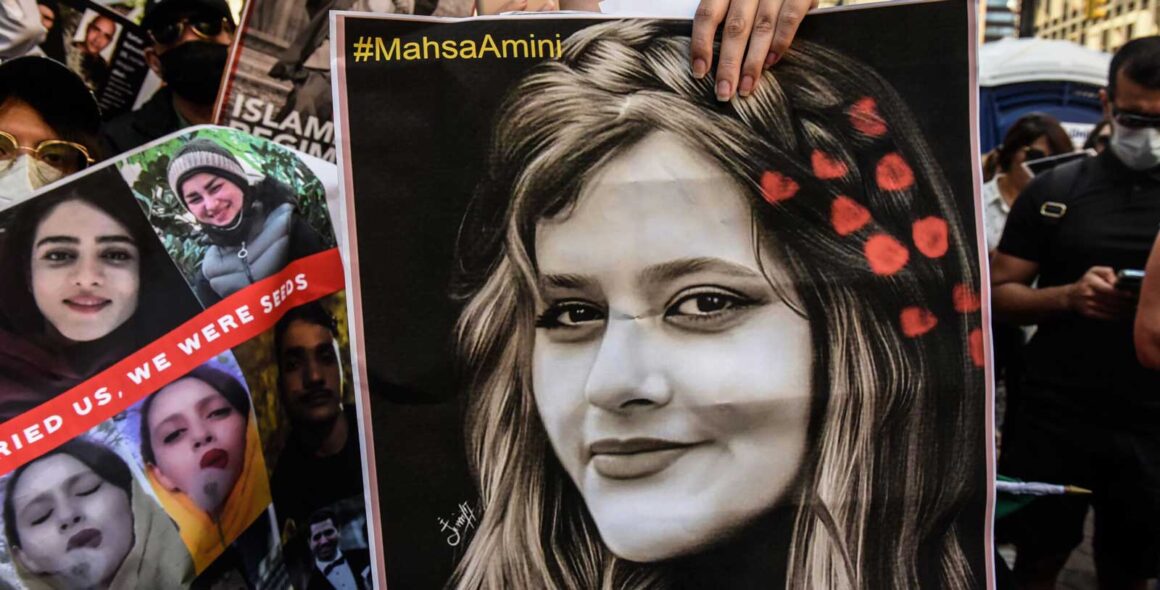

By Resa Ludivien
A WOMAN is dead. Mahsa (Kurdish name Jina) Amini was only 22 years old. Iranian “morality police” initially arrested her for allegedly wearing the wrong clothes.
Jina died in police custody after falling into a coma, murdered by the police. Opposition circles believe it was a skull fracture. The police counter with a video supposedly showing Jina falling down by herself.
Protests and repression
Such issues are now beside the point. People are no longer willing to accept that it is justified to arrest a young girl because she was wrongly dressed in the eyes of the state. The outrage is all the greater, because it could have affected so many others. This anger, grief and fear have brought both women and men onto the streets. Their protests are directed against the dictatorship and have spread to many cities, despite the brutal repression. As a sign of their solidarity, women took off their headgear and cut their hair, echoing protests against the dress code between 2017 and 2019.
The state’s reaction has been aggressive, brutal, despotic. Videos on the net show water cannon and police squads opening live fire on protesters. By September 23, 36 people are said to have been killed.
The government, on the other hand, is trying to return to “business as usual”, mobilising reactionary demonstrations loyal to the regime and agitating against the demonstrators. President Raisi travelled to the UN Assembly and all he could say was that the death would be investigated. He denounced the mass protests as the work of “Chaotics”. The military and secret services are also blatantly threatening the “enemies” and “illegal gatherings”.
The protests are now about so much more than the murder of Jina Amini. The economic situation in the country is devastating. In addition to the sanctions that have been in place for years, their impact made worse by the corona pandemic and obstacles to vaccine procurement, people have been hit by massive inflation for years. According to official figures, it is estimated to be at least 50% for this year.
Although the regime raised wages and pensions after protests by workers and pensioners in the summer of this year, this was little more than a drop in the ocean after years of losses – and everyone knows that price increases will quickly eat up any gains. Just as demonstrating women are now denounced, in June, demonstrators who took to the streets for higher incomes were branded as “foreign enemies”.
In addition, there is the desire of Iranians for more freedoms, which is reflected again and again in protests by young people. In Jina’s case, Kurds are oppressed nationally and those from other countries are usually only tolerated. This toleration is often accompanied by harassment and even faster use of force by the state.
Rule of the Ayatollahs
Since the Iranian Revolution in 1979, which quickly developed into a counter-revolution, the arch-conservative Islamic Ayatollahs have ruled. The overthrow of the Shah meant that the US lost a central political vassal in the region and the successor regime met with its bitter hostility, but also that of regional powers such as Iraq (under Saddam Hussein), Saudi Arabia and Israel. To this day, the Islamist regime uses this confrontation to present its dictatorship as a kind of “alternative path of development” beyond imperialist control. The “critique” of the imperialist system was reduced to the critique of the “West” or even of “modernity” and its greater equality.
Of course, the justification of oppression of women on religious grounds did not begin with the mullahs. Rather, systematic oppression is based on millennia of a patriarchal social order, which was retained under bourgeois rule and reproduced in capitalist relations. It is therefore essential not only to fight for equal democratic rights, but also to change the relations of production in order to achieve the final equality of women in the factory, family and society.
Mass protests by millions of courageous women, and men in solidarity, represent a first step towards shaking up this system, questioning the dress code and the government. At the same time, as the call for the overthrow of the mullah regime shows, they raise the question of a grander perspective, with angry protesters storming state institutions and buildings and engaging in street battles with the repressive forces.
Programme
In recent years, there have been repeated protests and strikes by the working class. The struggle for women’s rights could become a spark that ignites the flame of a new uprising and brings these movements together.
In order to successfully combine the resistance against the oppression of women with that against price increases and impoverishment of the working class and the mass of the people, the protests must also take root in the factories and offices. A mass strike in the country could unleash a force that not only shakes the mullahs’ regime, but overthrows it, a force that will break up the apparatus of the “morality police” and all repressive forces, once and for all.
Such a movement would have to be coordinated by strike and action committees and protected by self-defence bodies. At the same time, these could become the basis for organs of power of a new society that gets rid of the mullah regime but does not allow itself to be chained to the interests and schemes of Western, imperialist forces.
For this, it would have to put an end to Iranian capitalism itself, expropriating capital and tackling social and economic problems through an emergency plan controlled by workers’ councils. Of course, this struggle in one country alone cannot lead to another, socialist society. But the movement in Iran could take an important step in that direction. That is why it needs the solidarity of the entire international labour, women’s and LGBTIAQ movement and the entire left!